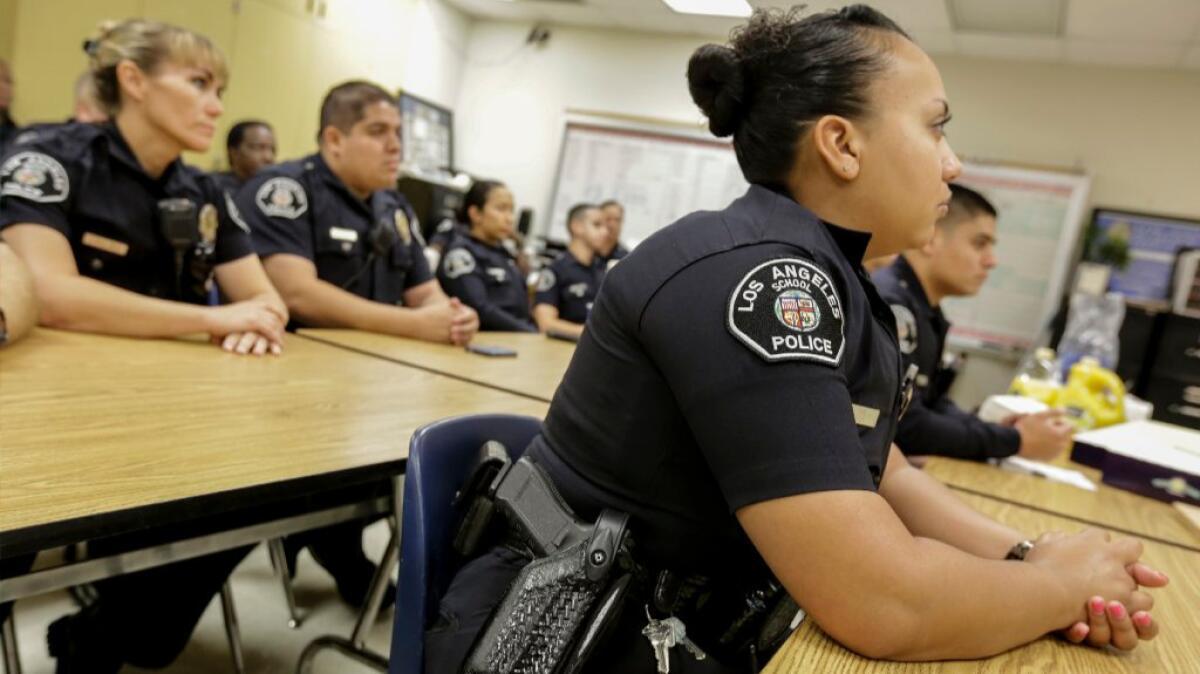Editorial: Defund the school police? It’s not that simple

- Share via
Parents’ concerns about fights among students and other safety issues have led to a growing police presence at public schools, whether the officers are hired as school employees or are provided by the local police department. Their numbers grew further after a series of high-profile tragedies in which a disturbed student or outsider brought guns to a school and killed multiple students and teachers. Although rare, these incidents created a misguided sense that campuses needed to be well-armed in self-defense.
Now, however, the nationwide protests against police killings of Black people have prompted some to question the armed presence at schools that was embraced after the Newtown and Parkland shootings. As protesters call for shifting funds from police departments to unarmed social service specialists, the question is natural: Why not do the same for kids? The leadership of United Teachers Los Angeles is calling for defunding L.A. Unified School District’s police department and spending the money on more counselors (who would be members of UTLA). Similar demands are being made across the nation.
School leaders should be open-minded yet cautious about their next moves. L.A. Unified was wise to hire and prepare its own police, who are trained in how to break up fights and intervene in other problems, generally with less use of force. Contracting with municipal police departments is more problematic; officers trained to respond to hardened criminals are seldom the right fit for kids.
Even so, any armed, uniformed police can be an intimidating sight on campus and make some students feel as though they are constantly under suspicion, even if the officers don’t treat them that way. Their visible presence can unfairly imply that schools, especially urban campuses with many Black and Latino students, are hotbeds of crime.
That said, some students like the security; it’s not uncommon to hear them say that they feel safer at school than on the path home.
Beyond dueling perceptions are the data. With close to half a million students and tens of thousands of employees, L.A. Unified has about the same size population of Albuquerque. Over the past two years, there have been more than 900 cases of battery, 130 cases of assault with a deadly weapon and nearly 190 threats of mass shootings, according to district figures. Counselors alone can’t cope with these and other violent or threatening incidents.
On a handful of occasions, L.A. Unified school police have used pepper spray on students; Superintendent Austin Beutner now says he favors ending the practice as well as banning choke holds. School personnel say they cannot remember a time when a school police officer has drawn a gun on campus.
But if pepper spray has been unnecessary, L.A. Unified should have stopped its use earlier, and chokeholds on students never should have been allowed. Beyond that, if school police have done their jobs without drawing a gun, maybe the district never needed hundreds of armed officers. Mass shootings, horrific as they are, do not justify regular armed police presence. They are extraordinarily rare; kids are more likely to die in drownings or bicycle accidents, according to a report from Northeastern University.
Such an infrequent threat must be weighed against the environment on campus when students more routinely see a police officer at school than a counselor or nurse.
Although completely dismantling school police forces could be a mistake, L.A. Unified should examine whether it needs all of its 344 armed and 95 unarmed officers, or whether a smaller number of roving officers would do, with the money used toward more counselors and social services.
Three proposals on the subject are expected to come before the board Tuesday. One deserves to pass.
Monica Garcia’s resolution is rash, simplistic and poorly thought out. It would almost eliminate the district police force over the next few years, cutting it to 10% of its current budget. Maybe this ultimately will be the way to go, but that is unknowable without better information and full public debate that gives voice to both sides.
George McKenna would direct a committee to examine whether school police guidelines or training should be overhauled. Examining the issue before making massive permanent change is a good idea, but the focus here is too narrow.
Jackie Goldberg has introduced by far the most thoughtful approach: Immediately but temporarily suspend use of pepper spray and police dogs; place police on the perimeters of schools, where they are a less intrusive presence; and have them wear civilian-style clothing. In the meantime, a panel would study a broad range of topics, including whether L.A. Unified needs a police force and if so, how it would best operate.
One particularly intriguing question the panel would ask is whether school police might be better deployed toward helping students with safe passage to and from school than policing them on campus. This has been a persistent safety problem that has been virtually ignored for far too long.
More to Read
A cure for the common opinion
Get thought-provoking perspectives with our weekly newsletter.
You may occasionally receive promotional content from the Los Angeles Times.










